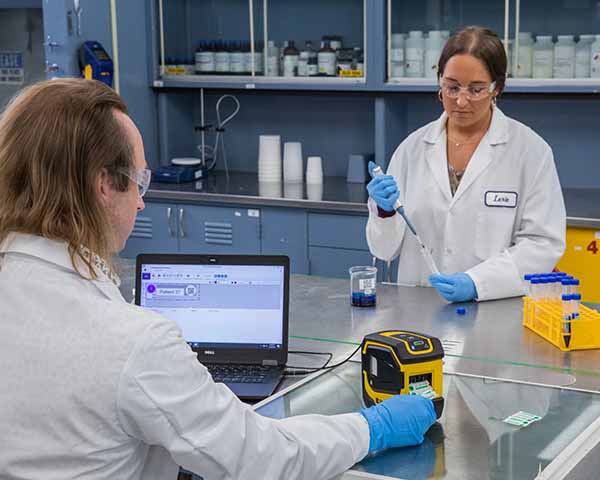Labels for Safety, Visuals and Facility ID Desktop Printers
Labels for Product, Wire and Lab ID Benchtop Printers
Labels for Safety, Visuals and Facility ID Desktop Printers
Labels for Product, Wire and Lab ID Benchtop Printers
Safety and Facility ID Desktop Printers
Product, Wire and Lab ID Benchtop Printers
Barcode Scanner and Printer Kits
Barcode Scanner and Printer Kits
PaintStripe Floor Marking Stencils
Valve Lockouts & Hose Lockouts
Group Lock Boxes & Permit Control
Brady Safety Lockout Tagout Services
Pipe Marker Accessories & Mounting Brackets
Maintenance and Production Tags
Calculators and Assessment Tools
Product Finders and Data Sheets
Precise and accurate lab sample management is not a nice-to-have in scientific research and analysis – it’s a must-have. Each lab sample holds vital information, a critical result, a potential breakthrough or more. And all it takes is a single bad label, mishandle or lost-in-the-shuffle moment to lead to disaster. But with a few lab sample management best practices and the right labels and tools, labs can protect themselves from potential pitfalls.
When data integrity and reproducibility are called into question, it jeopardizes results and the work – sometimes years – that went into gathering them. Proper sample identification and sample tracking ensure sample integrity so outcomes can be validated.
Lab research can be closely regulated due to potential risks associated with various samples, chemicals and substances. Compliance, including labeling, is essential to maintaining safety, the environment and your legal obligations. These standards and regulations may include:
Mistakes in lab sample management can be financially burdensome and time-consuming. Mislabeling or losing samples can lead to repeated experiments, wasted resources and prolonged project timelines.
Some labs require long-term sample storage. Improperly managed samples can degrade over time, rendering them useless for future research. With proper sample identification, labeling and storage procedures in place, the viability of samples can be preserved.
Sample loss has far-reaching consequences. Not only does it lead to financial losses due to wasted resources, but it also consumes valuable time that could be better spent on advancing research.
Mislabeled samples can lead to incorrect experimental outcomes. Researchers may unknowingly use the wrong samples, resulting in flawed data that cannot be relied upon during validation and peer review.
Even if they’re found, misplaced samples disrupt the workflow of a laboratory. Researchers spend unnecessary time searching, which hampers productivity and slows processes.
A robust sample management protocol should be established, outlining every step from sample collection to disposal. Written policies should detail components, including:

Consistency is key to successful lab sample management. Standardized procedures ensure that all laboratory staff handle and store samples in the same manner, minimizing the risk of errors. Outline each step of the sample handling process and ensure procedures are regularly reviewed and updated. Throughout the process, encourage staff feedback to glean valuable insights and improve the process.

Printing on high-quality lab labels ensures that labels remain legible and intact over time. Utilizing materials and lab printers built for lab environments is a proactive approach to prevent errors.

Barcode labels are machine-readable codes that consist of a series of lines, numbers, or symbols. In the laboratory, they act as unique identifiers for samples, enabling rapid and error-free data entry. Advantages include:
Barcode scanners may integrate with Laboratory Information Management Systems (LIMS), creating a cohesive system that automates data input and retrieval. Automated lab labeling and sample tracking through barcodes and LIMS ensure seamless data flow, real-time updates and better data accuracy.
Barcode-enabled systems automate inventory tracking so laboratories can quickly find the location and status of each sample. This expedites processes and reduces downtime spent searching for samples. It also outlines a comprehensive audit trail of sample movements, often critical for maintaining compliance with industry regulations and quality assurance standards. Lastly, barcoding allows laboratory staff to focus on mission-critical responsibilities rather than manual record-keeping tasks.

For heightened security, laboratories may implement a chain of custody system. Chain of custody systems:
This increased security is especially important in industries where lost or misidentified samples can have dramatic effects. Consider the consequences of a lost sample in a forensic laboratory, for example.

Proper training is essential for laboratory staff to understand and follow sample management protocols. Without training, protocols and standards can become quickly forgotten or unintentionally ignored. Consider implementing:

It bears repeating — precise and accurate lab sample management is not a nice-to-have in scientific research and analysis — it's a must-have. That said, it's also a very achievable objective if you follow these best practices and properly label samples using the appropriate tools to ensure easy identification and compliance. In achieving optimal lab sample management, you will avoid costly pitfalls of ruined specimens and lost time and productivity so you can concentrate on your sample objectives without worry.
Don’t worry. Experimenting is part of the process.